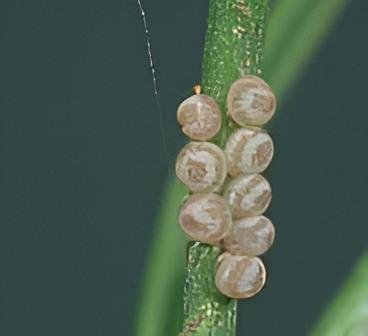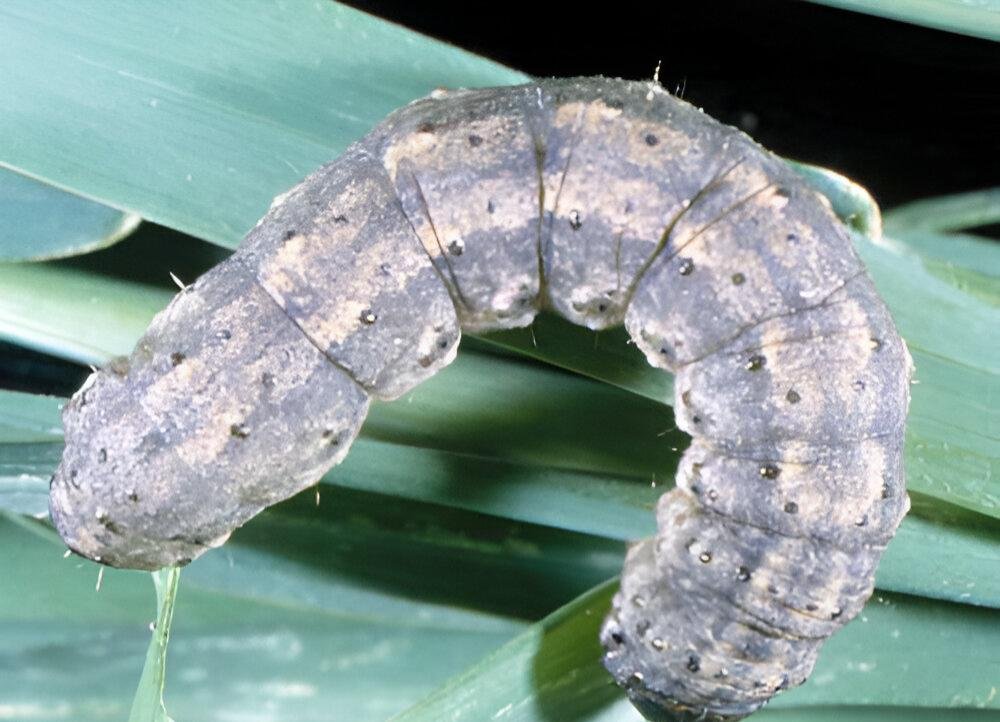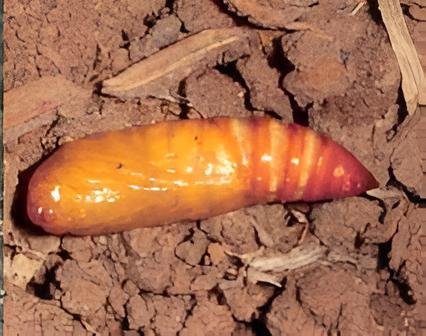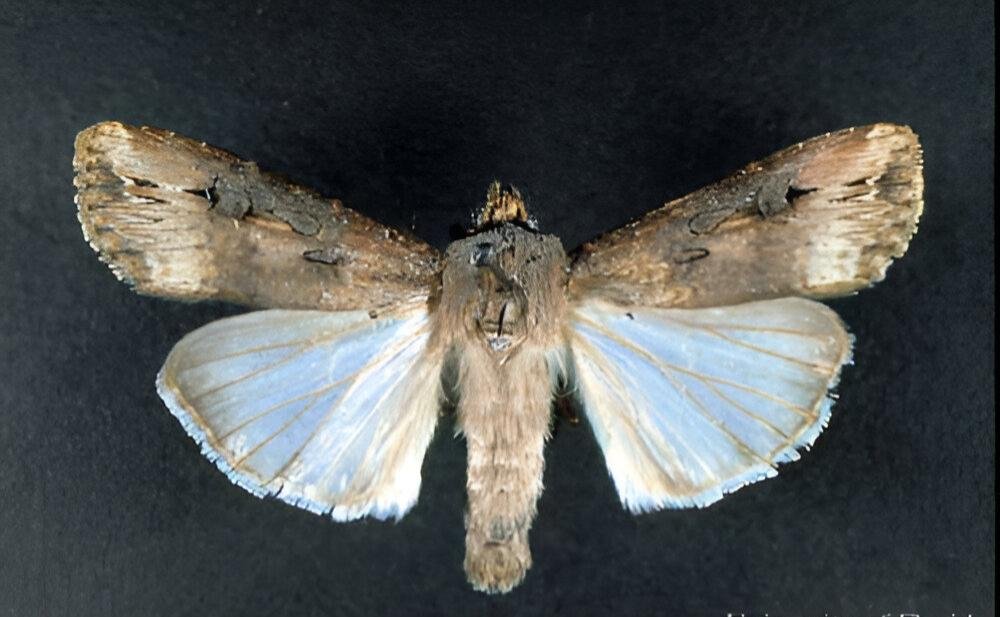Table of contents of the article
ToggleThe zucchini cutworm is a serious pest of zucchini crops, causing cuts in the stems and significant damage to the plants. In this article on your website, World of Plants, we will learn about effective ways to combat it.
Symptoms of cutworm in zucchini
- the family : Lepidoptera
- Scientific name : Agrotis ipsilon
- Small caterpillars make irregular holes on tender leaves.
- Large larvae bite the seedling at or slightly above the soil surface, leading to the stem being completely or partially cut off.
- The large larvae burrow into the stems of large plants, causing the plants to wilt and tilt to become parallel to the ground.
Description of cutworm in zucchini
- The adult is fairly large, with a wingspan of 40 to 55 mm. The forewing, especially the proximal two-thirds, is uniformly dark brown. The distal area is marked with a lighter irregular band, and a small but distinct black dash extends distally from the bean-shaped wing spot. The hindwings are white to grey, and the veins are distinguished by dark scales.
- Egg: The color of the egg is white at first, then turns brown as it ages. They are 0.43 to 0.50 mm high, 0.51 to 0.58 mm wide, and are roughly spherical in shape with a slightly flattened base. The egg bears 35 to 40 ribs radiating from the apex. The ribs are alternately long and short.
- Larvae: There are five to nine instars, with a total of six to seven instars being the most common. The larvae are uniformly colored on the dorsal and lateral surfaces, ranging from light gray or grayish brown to almost black. In some individuals, the dorsal region is slightly lighter or brown, but the larva lacks a distinct dorsal stripe. Ventralally, the larvae tend to be lighter in color.




Causes of cutworm in zucchini
- The stem of the seedling is tender when the number of larvae in the soil increases and in the case of high temperature, as the time required for the eggs to hatch decreases to 3 days at 30 degrees Celsius.
- Neglecting field operations such as pruning, balanced fertilization, and hoeing.
- Do not remove weeds and plant residues from the field, as they are considered a haven for the pest.
- Lack of attention to the agricultural distances between plants.
- Do not plow the soil and fertilize it with appropriate organic fertilizer.
Suitable conditions for the spread of cutworms in zucchini
- Larval development is strongly influenced by temperature, with the ideal temperature being around 27°C. Humidity is less important, but the first to fifth instars thrive best at high humidity.
- Close plant seedlings together.
- Sexually mature females are more competitive than their younger counterparts by summoning and attracting males first (i.e. the injury increases the more they are neglected).
Cutworm development cycle in zucchini
- The number of generations that occur annually varies depending on weather conditions. Moths are present in the months of March and May, June and July, July and August, and September and December.
- The duration of the life cycle is usually 35 to 60 days.
- The pre-incubation period for adults is about seven to 10 days. Moths preferentially choose low-growing, broad-leaved plants to lay eggs, but the absence of these plants will lay eggs on dead plant material. Soil is an unsuitable location for laying eggs.
- Eggs are usually laid in clusters on tree leaves. Females may lay 1,200 to 1,900 eggs. The duration of the egg stage is three to six days.
- The duration of the larval stage usually ranges from 20 to 40 days.
- The larvae usually remain on the plant until the fourth instar, hiding in the soil during daylight hours. In these last stages, it also tends to cut plants at the surface of the soil, and pull the plant tissue underground
Cutworm infestation losses in zucchini
- Caterpillars can consume more than 400 square centimeters of foliage as they grow.
- A dangerous pest with a wide family range that affects plants during the germination and seedling growth stage, causing a large absence of leaves, forcing the farmer to perform patching or replanting, thus delaying the crop and exposing him to pests in the late stages of growth.
- 4-day-old females begin calling early. Thus, sexually mature moths are more competitive than their younger counterparts by calling and attracting males first (i.e., infection increases the longer they are neglected).
Control strategy
Preventive measures to prevent cutworm occurrence in zucchini
- To identify a problem early, look for signs of cutworms, such as missing or damaged plants.
- Practice good orchard hygiene, such as removing plant debris and weeds that can harbor cutworms.
- Plow the land well and leave it exposed to the sun for a long time, with repeated plowing, solarization, and ventilation to kill the larvae and pupae hiding in it by exposing its various stages to sunlight and natural enemies.
- Heavy irrigation.
- Collecting and burning crop residues.
Organic control recommendations against cutworm in zucchini
- Collect the larvae by hand from around and under the roots of infected seedlings. This method is only suitable in small spaces or in vegetable nurseries.
- Use natural predators, such as birds, to control cutworm populations.
- Use poisonous baits to treat Cutworm in zucchini As follows: 25 kg of corn grits or wheat bran + 20 liters of water + a suitable pesticide according to the recommended rate + an attractant such as sugar or treacle. The poisonous bait is spread near the plants before or during sunset, and the soil must have adequate moisture
- Light or pheromone traps can be used to control adult insects
Chemical control recommendations against cutworm in zucchini
- It is implemented when the infestation begins to appear. Among the most important pesticides used to combat this pest and currently circulating in Yemen are: fenvalerate, imidaclopride, indoxacarb, emamectin benzoate, thicyclam hydrogen oxalate, deltamethrin and others.
In conclusion, we would like to note that we, at the world of plants website, offer you all the necessary services in the world of plants, we provide all farmers and those interested in plants with three main services::-
- Artificial intelligence consulting service to help you identify diseases that affect plants and how to deal with them.
- Blog about plants, plant diseases and care of various crops ... You are currently browsing one of her articles right now.
- An application that provides agricultural consultations to clients, as well as a service for imaging diseases and knowing their treatment for free – Click to download the Android version from Google Play Store، Click to download the IOS version from the Apple App Store.
references:-
- SWIER, Stanley R.; RINGS, R.W.; MUSICK, GJ Age-related calling behavior of the black cutworm, Agrotis ipsilon. Annals of the Entomological Society of America, 1977, 70.6: 919-924.
- Abdel-Gawaad AA, El-Shazli AY. 1971. Studies on the common cutworm Agrotis ypsilon Rott. I. Life cycle and habits. Zeitschrift fuer Angewandte Entomologie 68: 409-412.
- Archer TL, Musick GL, Murray RL. 1980. Influence of temperature and moisture on black cutworm (Lepidoptera: Noctuidae) development and reproduction. Canadian Entomologist 112: 665-673.
- Abdel-Gawaad AA, El-Shazli AY. 1971. “Studies on the common cutworm Agrotis ypsilon Rott.” I. Life cycle and habits.” Zeitschrift fuer Angewandte Entomologie 68:409–412.
- Archer TL, Musick GL, Murray RL. 1980. “Influence of temperature and moisture on black cutworm (Lepidoptera: Noctuidae) development and reproduction.” Canadian Entomologist 112:665–673.
- Age-Related Calling Behavior of the Black Cutworm, Agrotis ipsilon – academic
- An insight into black cutworm (Agrotis ipsilon): A glimpse on globally important crop pest – sciencevision
- black cutworm – entnemdept




